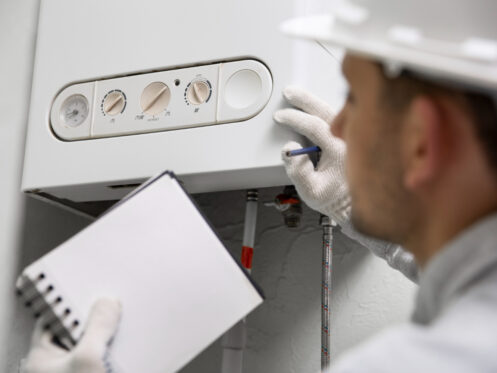Taking care of your water heater is one of those home maintenance tasks that’s easy to forget but can save you a lot of money in the long run. Many homeowners wonder how often should a water heater be serviced.
Water heaters should be flushed and inspected once per year for most households, or every six months if you have hard water.This regular maintenance helps prevent mineral buildup, extends the life of your unit, and keeps it running efficiently.
A well-maintained water heater can last several years longer than a neglected one, potentially saving you hundreds or even thousands of dollars in replacement costs. We’ve found that simple maintenance steps like checking the pressure relief valve, inspecting the anode rod, and insulating the tank can make a big difference in performance.
These tasks don’t require special skills, but they do need to be done regularly. In this article, we’ll walk you through the essential maintenance tips that will keep your water heater running smoothly for years to come.
Through the topics below, you’ll learn what maintenance your unit needs and when to do it:
- Why your water heater needs regular servicing
- How often to service your water heater (based on type)
- Essential water heater maintenance tasks
- Professional water heater tune-ups in Orange County
Let’s dive in!
Why your water heater needs regular servicing
Regular water heater maintenance protects your investment and ensures reliable hot water when you need it. Without proper care, even the best units can fail prematurely and cost you significantly more in energy bills and repairs.
Sediment buildup and efficiency loss
Minerals from your water supply settle at the bottom of your tank over time. This sediment layer acts as an insulator, forcing your heater to use more energy to heat water. In areas with hard water, this buildup happens even faster.
When sediment accumulates, your water heater must run longer to reach the set temperature. This extra work translates directly to higher energy bills – sometimes increasing costs by 10-30%.
To prevent this, the EPA’s Home Maintenance Guideadvises homeowners to “flush your water heater to reduce sediment buildupwhich can decrease efficiency” and recommends a professional inspection at least once a year.
This simple maintenance task removes the accumulated sediment and helps maintain efficiency.
Some signs of sediment buildup include:
- Popping or rumbling noises during heating
- Longer heating times
- Less hot water available
- Fluctuating water temperatures
Signs your unit is working harder than it should
Water heaters often show warning signs before major problems develop. Unusual noises like rumbling, popping, or banging indicate sediment interacting with heating elements. These sounds mean your unit is struggling.
Rusty water or a metallic smell suggests internal corrosion, often from a failing anode rod. This protective component needs checking during maintenance visits.
Temperature inconsistencies are another red flag. If your shower suddenly turns cold or water takes longer to heat, your unit is likely working inefficiently.
Rising energy bills without increased usage point directly to decreasing efficiency. By monitoring your bills, you can spot problems early before they lead to complete failure.
How skipped maintenance leads to early breakdowns
The average water heater should last 8-12 years, but without regular maintenance, many fail around year 6 or 7. This early replacement costs thousands of dollars that could have been avoided.
Neglected maintenance creates a domino effect of problems:
- Sediment buildup insulates heating elements
- Heater works harder and stays on longer
- Components wear out faster
- Energy bills increase
- Complete system failure occurs prematurely
A failing pressure relief valve due to lack of maintenance creates dangerous pressure buildups. In extreme cases, this can lead to tank ruptures or leaks that cause significant water damage to your home.
Annual professional inspections cost $75-150 but can prevent $1,000+ emergency repairs or premature $1,200+ replacements. This makes regular maintenance one of the most cost-effective home care investments.
How often to service your water heater (based on type)
Different types of water heaters have varying maintenance needs based on their design, usage patterns, and water quality in your area. Following the right service schedule can extend your unit’s life and prevent costly repairs.
Traditional tank water heaters
Tank water heaters typically need service once per year. This annual maintenance includes flushing the tank to remove sediment buildup, checking the anode rod, and inspecting valves and connections.
The U.S. Department of Energyrecommends flushing “a quart of water from the storage tank every three months” and checking the temperature‑and‑pressure (T&P) valve every six months
In areas with hard water, like parts of Orange County, you might need to flush your tank every 6 months. Sediment builds up faster in these regions and can cause:
- Reduced efficiency
- Strange noises
- Shorter heater lifespan
- Higher energy bills
The anode rod should be checked annually and replaced every 3-5 years. This $20-40 part protects your tank from corrosion and can extend your heater’s life by years.
For older tanks (8+ years), consider increasing service frequency to twice yearly as components wear down.
Tankless water heaters
Tankless systems generally require professional service once every 1-2 years. The average service interval depends on your water quality and usage patterns.
For homes with hard water, annual descaling is crucial to prevent mineral buildup in the heat exchanger. This maintenance keeps your unit running efficiently and prevents premature failure.
DIY maintenance for tankless units should include:
- Monthly visual inspections
- Cleaning external filters every 4 months
- Checking for error codes or unusual operation
Professional service should include descaling the heat exchanger, checking electrical components, and testing safety features. These services typically cost $150-300 but save much more in preventing repairs.
High-efficiency or hybrid systems
Hybrid water heaters combine heat pump technology with traditional heating elements. These sophisticated systems need professional inspection annually to maintain peak efficiency.
Key maintenance tasks include:
- Cleaning air filters every 2-3 months
- Annual inspection of the heat pump components
- Checking refrigerant levels
- Testing backup heating elements
These systems have more components that can fail, but proper maintenance keeps them operating at their advertised 3.5-4.0 energy factor. The extra care pays off through 60-70% lower energy costs compared to traditional tanks.
For hybrid systems in cooler climates, air filter maintenance becomes even more important as the units work harder.
What manufacturers recommend (and why it matters for warranties)
Most manufacturers recommend annual professional service for all water heater types. This isn’t just to sell services—it directly impacts your warranty coverage.
Important warranty considerations:
- Missing scheduled maintenance can void warranties
- Many manufacturers require proof of professional service
- Some warranties only cover parts, not labor
- Documentation of service history is crucial for claims
A.O. Smith, Rheem, and Bradford White typically offer 6-12 year warranties that require documented maintenance. Keep all service records and receipts.
We’ve seen many warranty claims denied in Orange County because homeowners couldn’t prove they followed maintenance schedules. The $150-200 annual service cost protects your larger investment and warranty coverage.
Essential water heater maintenance tasks
Regular maintenance keeps your water heater running efficiently while extending its lifespan. These simple tasks can help prevent costly repairs and reduce energy consumption.
Flushing the tank to remove sediment
Sediment buildup is the number one enemy of water heater efficiency. We recommend flushing your tank at least once a year, or every six months if you have hard water.
Here’s how to flush your water heater:
- Turn off the power/gasto the water heater
- Close the cold water inlet valve
- Connect a garden hoseto the drain valve
- Open the drain valveand let water flow until clear
- Close the drain valve, disconnect the hose, and restore power
This simple process removes mineral deposits that can cause overheating and damage heating elements. The result is better efficiency and lower energy bills.
Checking the anode rod and temperature settings
The anode rod is a sacrificial component that prevents tank corrosion. We should inspect it annually and replace it when it’s less than 1/2 inch thick or heavily corroded.
To check the anode rod:
- Shut off power and water
- Locate and unscrew the rod from the top of the tank
- Replace if significantly deteriorated
Temperature settings also deserve attention. Setting your water heater to 120°F (49°C) is ideal – hot enough for household needs while preventing scalding and reducing energy costs by 3-5% compared to higher settings.
Inspecting valves, connections, and burner performance
The pressure relief valve is a critical safety component. Test it twice yearly by lifting the lever and confirming water flows freely. If it doesn’t release water or continues dripping after closing, replacement is necessary.
Check all pipe connections for leaks or corrosion. Even small drips can lead to significant water damage over time. Look for rust, mineral buildup, or wet spots.
For gas water heaters, inspect the burner assembly annually. The flame should burn blue – a yellow flame indicates incomplete combustion. Clear away dust and debris to ensure proper airflow and efficient operation.
These regular checks prevent unexpected failures and keep your water heater operating at peak efficiency.
Professional water heater tune-ups in Orange County
In Orange County, professional water heater maintenance is essential for keeping systems running efficiently through all seasons. Local plumbing experts offer specialized services that go beyond basic DIY maintenance to ensure maximum performance and longevity.
What’s included in a service from Splash Plumbing
At Splash Plumbing, we perform comprehensive water heater tune-ups that address all aspects of your system. Our licensed technicians start with a thorough inspection of all components including heating elements, thermostats, and pressure relief valves.
We check for sediment buildup and perform a complete tank flush to remove minerals that reduce efficiency. This is especially important in Orange County where water hardness can vary significantly.
Our professionals also:
- Test water temperature settings
- Inspect anode rods for corrosion
- Check gas connections (for gas heaters)
- Examine electrical connections (for electric models)
- Test pressure relief valve functionality
Each service includes a detailed report of your water heater’s condition with recommendations for any necessary repairs or future maintenance.
When DIY isn’t enough (or safe)
While basic maintenance like visual inspections can be done yourself, certain tasks require professional expertise. Working with gas lines or electrical components presents serious safety hazards without proper training and tools.
Complex issues such as unusual noises, leaks, or inconsistent water temperatures often indicate problems that DIY solutions can’t address effectively. In these cases, a licensed plumber from Splash Plumbing can diagnose and resolve issues before they become costly emergencies.
Orange County residents with older water heaters (7+ years) benefit most from professional service. Aging systems need expert attention to identify potential failure points that aren’t obvious to homeowners.
Professional tools can detect issues like hairline cracks or pressure problems that might go unnoticed until major damage occurs.
How routine tune-ups save money and extend lifespan
Regular professional maintenance typically costs $75-150 annually in Orange County, but this investment prevents much larger expenses down the road. A well-maintained water heater uses 10-15% less energy, directly reducing monthly utility bills.
We’ve seen properly serviced water heaters last 12-15 years, compared to just 8-10 years for neglected units. This extended lifespan means thousands saved on premature replacement costs.
Routine tune-ups prevent:
- Emergency repairs(often 2-3× the cost of regular maintenance)
- Water damagefrom preventable leaks
- Inefficient operationthat wastes energy
- Premature failurerequiring full replacement
Our Orange County customers who schedule annual professional maintenance report fewer disruptions to hot water service and more consistent performance year-round.
Conclusion
Regular water heater maintenance is essential for optimal performance and longevity. We recommend servicing your water heater at least once a year, but those with hard water should consider maintenance every 6 months.
Professional servicing costs between $150-200 annually, but this investment can save you $500-800 in prevented problems each year. Plus, you stay in control of your maintenance schedule rather than letting equipment failures dictate repairs.
By following maintenance tips, you’ll extend your water heater’s lifespan, improve its efficiency, and ensure a consistent supply of hot water. The small effort now prevents major headaches and expenses later.
Remember that maintenance requirements vary based on your water quality. Homes with very hard water (>10.5 gpg) should flush every 3-4 months, while those with moderately hard water (3.5-7.0 gpg) can typically manage with annual flushing.
Your water heater works hard daily. Taking care of it properly means it will take care of you for many years to come.
Stay ahead of costly repairs, schedule your water heater maintenancetoday with Splash Plumbing.












